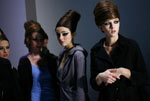Art
Calligraphy brushes
Updated: 2011-02-17 17:19
(Chinaculture.org)
Among the various calligraphic tools, the calligraphy brush is special to China. It represents one of the four treasures of study, which also include paper, ink and ink stone.
 |
|
Chinese calligraphy brushes |
The calligraphy brush has a long history in China. Legend has it that the brush was invented by Meng Tian (? - 210 BC), a general under the First Emperor of the Qin Dynasty (221-206 BC). However, primitive painted pottery contains decorative designs painted by tools resembling a brush. Visible stains or brush marks clearly remain in certain places on the pottery. This evidence suggests that the brush may have predated written language itself.
The history of the Chinese calligraphy brush can be traced back at least 6,000 years. The brush unearthed in the tomb of Marquis Yi of the Zeng State in Hubei province is the earliest brush discovered so far. Shown by the unveiled relics, in every past dynasty, since the Qin Dynasty the manufacture process of making a calligraphy brush has been in complete conformity. For instance, in 1975, in No.169 Jiangling Tomb, Hubei province, a brush of early West Han Dynasty with cavity at one end was unearthed. It shows that before the Qin Dynasty the head of the brush was bundled around the shaft with threads while afterwards the head was stuck into the cavity. This amendment made the brush easier to recieve ink, improving both the speed and quality of writing, as well as the portability of the brush.
 |
|
Calligraphy brushes of different sizes |
A calligraphy brush comprises of two parts: the head or brush tip and shaft. The head is made of goat, wolf, rat or rabbit hair, which is softer than bamboo, a pencil, quill or ballpoint pen. The shaft is made of bamboo, wood, lacquer or porcelain, as well as some precious materials, including mother-of-pearl inlays, ivory and jade.
There are four types of famous calligraphy brushes in China. 1. The Hu Writing Brush, produced in Huzhou city, Zhejiang province.
The Huzhou writing brush falls into four categories. The first is made of goat hair, which is very flexible; the second, of brownish rabbit hair; the third, of stiff weasel hair; and the fourth is a mixture of goat and weasel hair, which is neither too flexible nor too stiff.
The workmanship of the brush is exquisite and complicated since it takes more than 120 processes to complete .
 |
|
Delicate writing brush |
These brushes are especially handy both for painting and calligraphy. The shaft of this type of brush is usually made of either red sandalwood or mottled bamboo, white porcelain or even with ivory. It is therefore regarded as the best-quality brush and the most exquisite handicraft.
2. The Xuan Writing Brush
The Xuan writing brush, together with the famous Xuan paper, is made in Jingxian county, Anhui province. In ancient times, Jingxian county was under the jurisdiction of Xuanzhou Prefecture, where the product got its name.
Scholars of the Jin Dynasty (256-420 AD) were especially fond of the Xuan brush. During the Tang (618-907 AD) and Song (960-1279AD) dynasties, Xuanzhou became a calligraphy brush manufacturing center, and the Xuan brush was listed as a tribute to emperors.
At that time, folk artisans made a breakthrough in craftsmanship in selecting materials and polishing the shaft. Brushes were both sharp and neatly cut, and plump and smooth at the tip, enabling artists to write and draw freely. The Xuan brushes, made elaborately from brownish rabbit hair, are considered to be the best and come at a very high price.
3. The Daiyuexuan Calligraphy Brush
This writing brush was originally made by the venerable artisan Dai Yuexuan. Now, the brush is well known in Beijing for its high quality and elaborate craftsmanship. With the semi-manufactured writing brushes from Huzhou of Zhejiang province as the main material, artisans used their immense skills to create a tool with a unique, sharp point, neat cut, with a smooth roundness and graceful stiffness at the tip. Because of these four characteristics, this brand enjoyed high prestige among artists and calligraphers.
Dai actually worked for a writing-brush workshop located by the east entrance to the Liulichang Cultural Street in Beijing 80 years ago. His brushes were much better than the brand from Huzhou, even though the same materials were used. Later on, the Daiyuexuan brand became renowned far and wide.
Specials

Kremlin buddies
Dmitry Medvedev and Vladimir Putin inspect Olympic preparations.

Lantern Festival
The Lantern Festival is celebrated across China.

New York Fashion Week
Models line up before a show during New York Fashion Week.